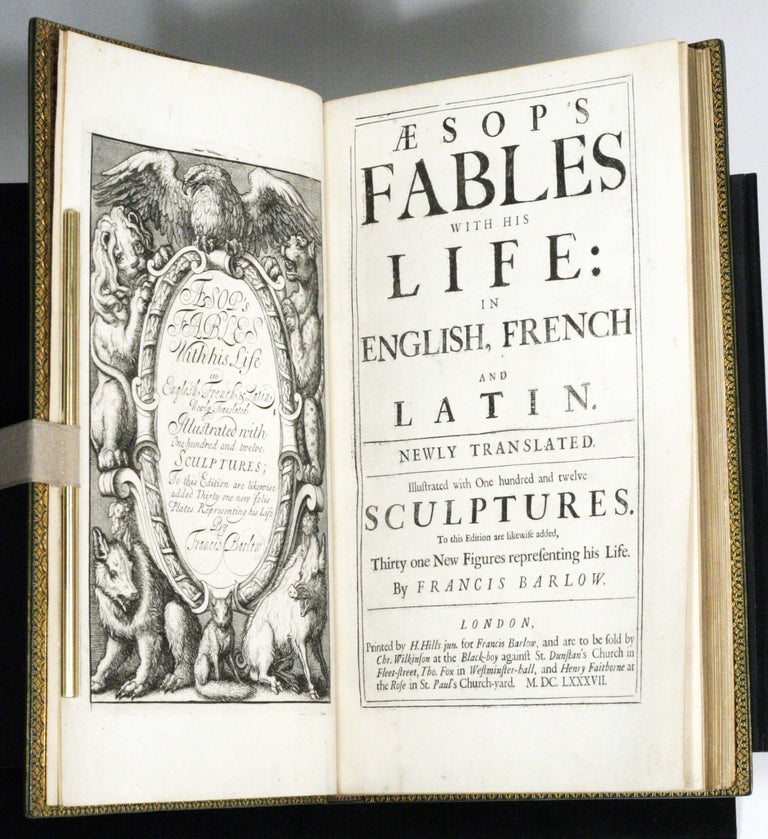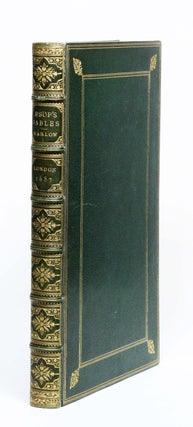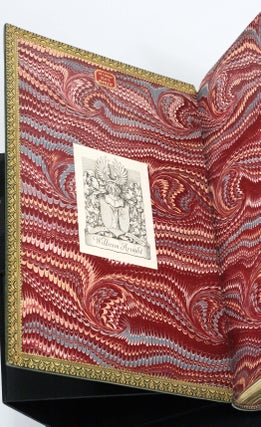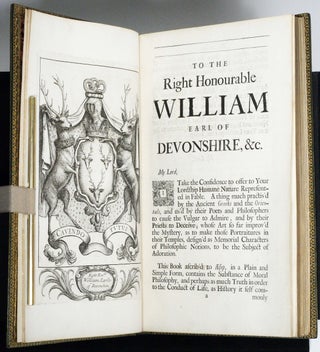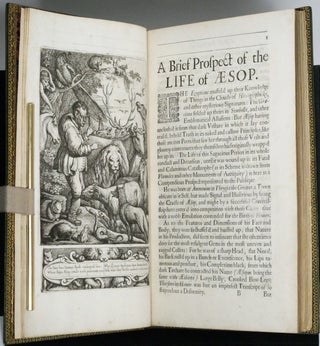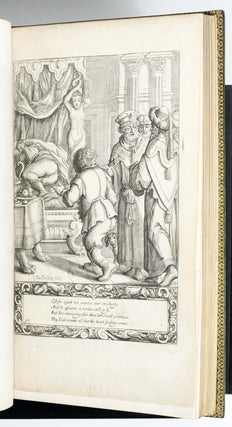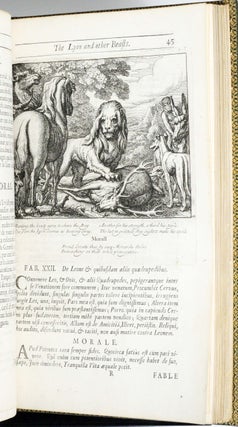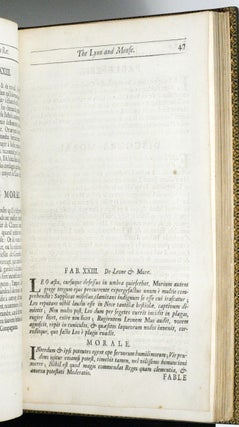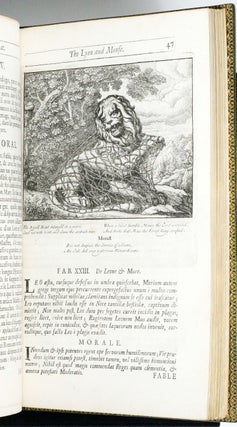Æsop’s Fables with His Life (1687)
“The least of creatures, the frog, the hare, the snake, and the swallow, and the least favoured of them, the ass, the boar and the wolf—he draws them all with an intimacy, charm, and inviolable integrity never surpassed in an English book.”
– Edward Hodnett, p. 185
FINE PINNACLE OF ENGLISH PRINTING HISTORY; RARE COMPLETE COPY IN HANDSOME BEDFORD BINDING.
Aesop’s Fables have stood at the forefront of Early Modern English book production, with Caxton selecting the works for one of his early printed texts, and Francis Barlow’s illustrated edition sits prominently both within Aesop’s post-Classical reception and modern literary history.
"Widely recognized as the leading English graphic artist of the second half of the seventeenth century”, Barlow self-published the first edition of his Aesop in 1665 in London (Flis, 479). But many copies did not circulate out of London before the Great Fire of 1666, which saw Barlow’s studio the Golden Eagle destroyed, though “the copper plates for the volume survived.” (O’Connell). Thus, a second edition was prepared using Barlow’s engravings, and expanded to include a biography of Aesop with new plates.
Why did Barlow chose Aesop’s Fables? Barlow was renowned in part for his ability to capture wildlife, with “hours of observation in the field, and close anatomical study” bolstering his “ability to bring the creatures of the hunt back to life” (Flis, p. 481). The lions, eagles, tortoises and wolves of Aesop may be more fanciful than the game Barlow more customarily drew, but, as he mentions in his preface, the fables suited precisely his “fancy, as consisting so much of Fowl and Beasts, wherein my Friends are pleas’d to count me most Eminent in what I doe.”
The seventeenth plate comprising the English translation of the fables is often found defaced, in attempts to obscure the depiction of a lady’s pudenda that accompanies the lines: “Oft for a jest we expose out modesty, | And to assume a vertue, tell a ly, | But here deceiving fair thou’dst small pretence, | Thy Taile wants all but the kind feeling sense.” The present plate does not display any signs of deletion or markings, but was likely added from a different copy at the time of binding.
Barlow’s edition is dedicated to William Cavendish, 1st Duke of Devonshire. It was published, however, before Cavendish was elevated from an earl to a duke in 1694—following his integral role in the Glorious Revolution, as one of the Immortal Seven who co-authored the Invitation to William [of Orange] which lay the scene for William & Mary’s reign. As the 4th Earl of Devonshire, Cavendish is thusly styled in the dedication as “The Right Honourable William Earl of Devonshire”. Facing the Dedicatory Letter is appropriately a full-page engraving of the 4th Earl of Devonshire’s heraldic achievement, before its later modification to suit the dukedom: sable, three buck’s heads cabossed argent; a Serpent nowed proper; On either side a Buck proper wreathed round the neck with a Chaplet of Roses alternately Argent and Azure. The later coat of arms for the Dukes of Devonshire were quartered to incorporate a score of further charges, whereas Barlow’s stately edition of Aesop’s Fables captures the earlier, starker blazon—unmistakable in its equanimous simplicity.
Provenance: Armorial bookplate of William Arnold, novelist and brother of Matthew Arnold; leather bookplate of Paul Harth; John Pearson (his sale, Sotheby's, London, 7 November 1916).
Binding: In masterful nineteenth-century binding with binder's stamp of Francis Bedford (1779–1883); "The work of Bedford is not excelled by that of any English bookbinder of his time." (Fletcher, p. 163).
AESOP [BARLOW, FRANCIS (TRANS.)]. Æsop’s Fables with His Life: In English, French and Latin. Newly Translated. Illustrated with One hundred and twelve Sculptures. To this Edition are likewise added, Thirty one New Figures representing his Life. London: Printed by H. Hills Jr. for Francis Barlow […], 1687. Second, illustrated edition. Folio (320 x 195 mm), [xii], 40 [The Life of Æsop], 31 [Dudley’s plates of Aesop's life], 40 [La vie d’Esope], 17 [Vita Æsopi], 221 [Les fables d’Esope], [2; contents], [7, blanks]; 3 frontispieces, 100 half-page engravings by Barlow and 31 full-page plates by Tho[mas] Dudley. Pls. 17 and 24 are shorter in the lower margin and likely were added from a different copy of the same edition at the time of binding. Binding signed by "F[rancis] Bedford": verdant morocco, du Seuil-style frame, ornate gilt spine, marbled endpapers, gilt dentelles, and gilt edges all round. Slight foxing reaching the illustration on p. 31, repaired closed tear on p. 185, duplicates of pp. 45 and 47 without engravings bound in; a few scratches to front board; text and plates crisp likely indicating an early impression. Wing A-696.
References:
Fletcher, William Younger, “Bedford, Francis”, Dictionary of National Biography, Supplement, ed. by Sidney Lee, 3 vols. (Oxford: Oxford University Press, 1901), I, pp. 162–63
Flis, Nathan, “The Drawings of Francis Barlow: From Apprenticeship to Aesop’s Fables”, Master Drawings 49.4 (2011), 479–532
Hodnett, Edward, Francis Barlow: First Master of English Book Illustration (Berkeley: University of California Press: 1978)
O’Connell, Shelia, “Barlow, Francis (d. 1704)”, Oxford Dictionary of National Biography, 23 September 2004.
Check Availability:
P: 212.326.8907
E: info@manhattanrarebooks.com


